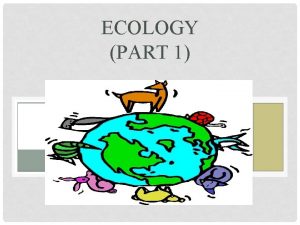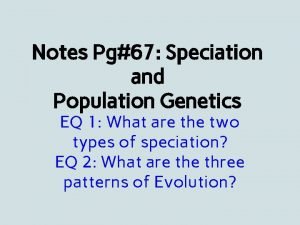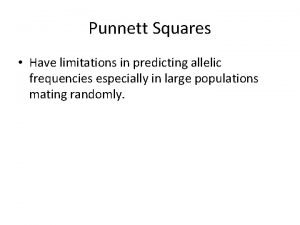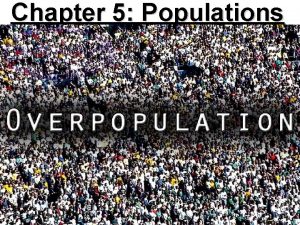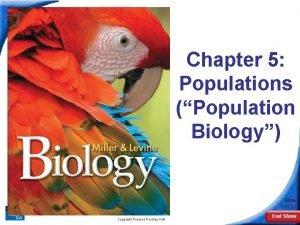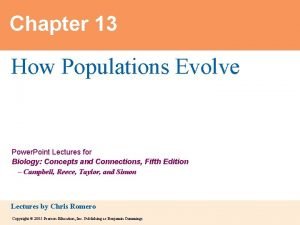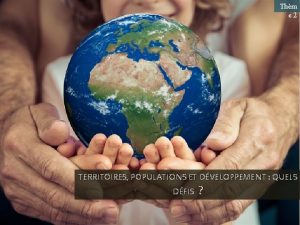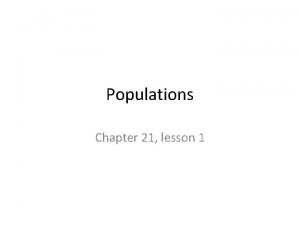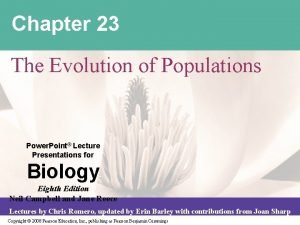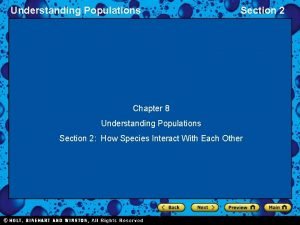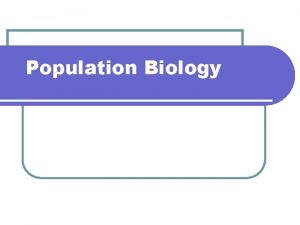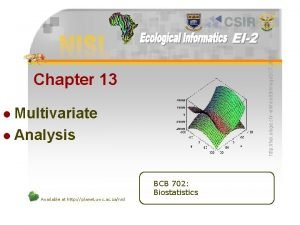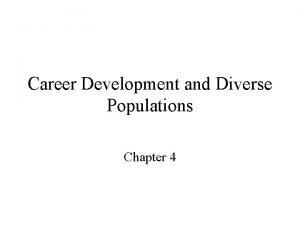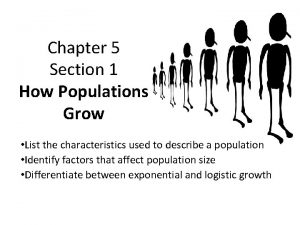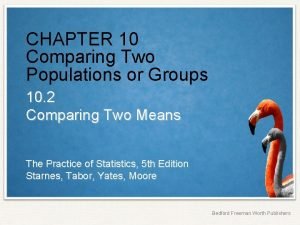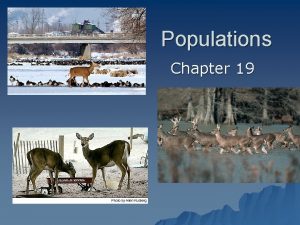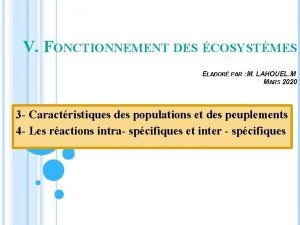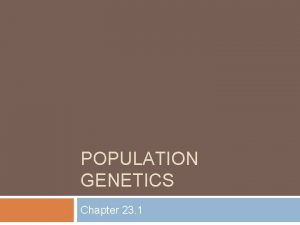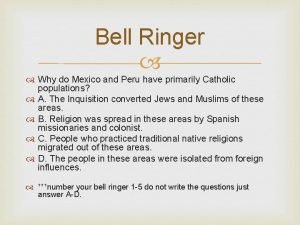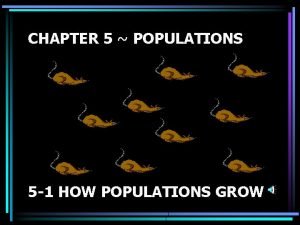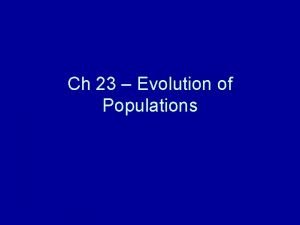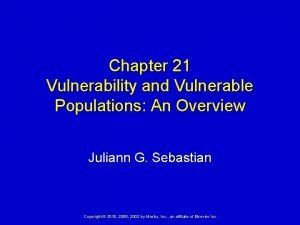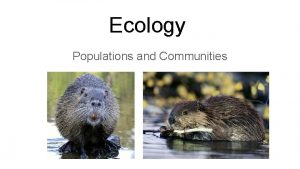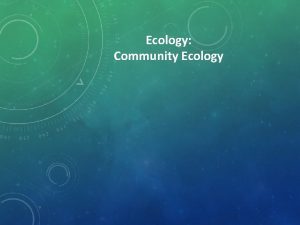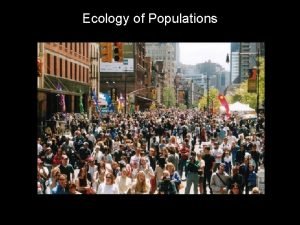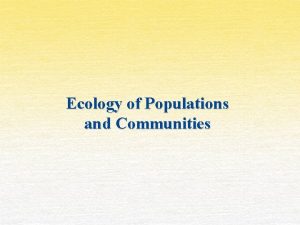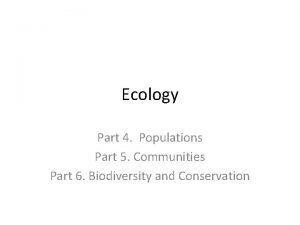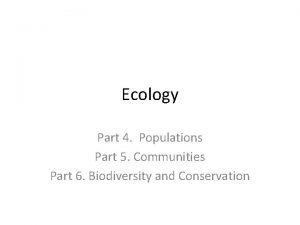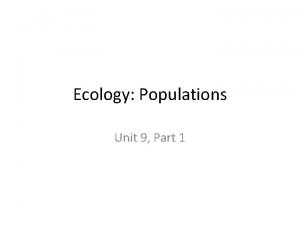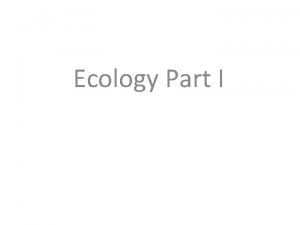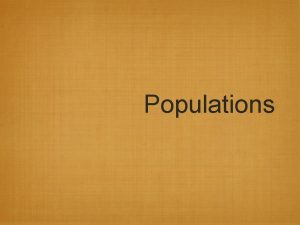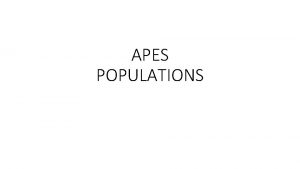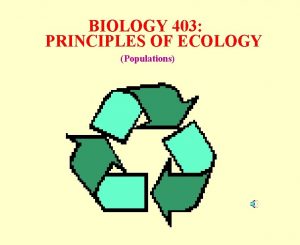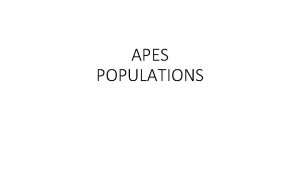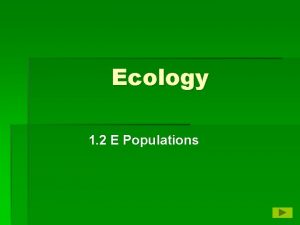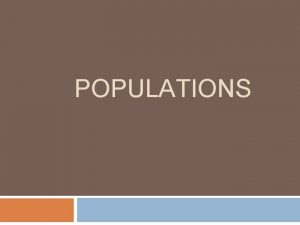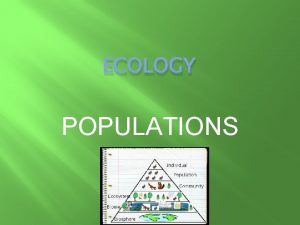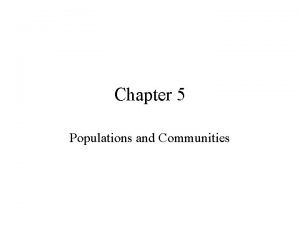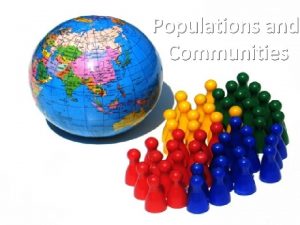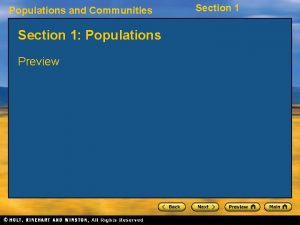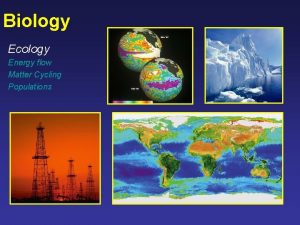Ecology Part 4 Populations Part 5 Communities Part






































- Slides: 38

Ecology Part 4. Populations Part 5. Communities Part 6. Biodiversity and Conservation

Population Ecology: Population Characteristics 1. Population Density: – The number of organisms per unit area 2. Spatial Distribution: – – Dispersion: The pattern of spacing a population within an area 3 main types of dispersion • • • – Clumped Uniform Random The primary cause of dispersion is resource availability

Population Ecology: Population Characteristics Population Limiting Factors 3. Population growth rate – How fast a given population grows – Factors that influence this are: • • Natality (____ birth rate) death rate) Mortality (_____ Emigration (the number of individuals moving _____ away from a population) moving to a Immigration (the number of individuals _____ population)

Population Ecology: Density-independent factors Population Limiting Factors • Density-independent factors – Factors that limit population size, regardless of population density. – These are usually abiotic factors – They include natural phenomena, such as weather events • Drought, flooding, extreme heat or cold, tornadoes, hurricanes, fires, etc.

Population Ecology: Density-dependent factors Population Limiting Factors • Density-dependent factors – Any factor in the environment that depends on the number of members in a population per unit area – Usually biotic factors – These include • • Predation Disease Parasites Competition

Population Ecology: Population Growth Rate Understanding Exponentials • Put your pens down for a minute & think about this: – An employer offers you two equal jobs for one hour each day for fourteen days. – The first pays $10 an hour. – The second pays only 1 cent a day, but the rate doubles each day. – Which job will you accept?

Population Ecology: Population Growth Rate Understanding Exponentials Now, how much would your employer owe you if you stayed at this job for another 2 weeks? Job 2 lags for a long time before exponential growth kicks in! What would happen if this type of growth took place within a population?

Population Ecology: Population Growth Rate What population do you think this is? What letter does this curve resemble?

The USCB estimates that the world population exceeded 7 billion on March 12, 2012

• Population growth models – Exponential growth model • Also called geometric growth or J-shaped growth. • First growth phase is slow and called the lag phase • Second growth phase is rapid and called the exponential growth phase • Bacteria can grow at this rate, so why aren’t we up to our ears in bacterial cells?

Population Limiting Factors • Population growth models – Limits to exponential growth • Population Density (the number of individuals per unit of land area or water volume) increases as well • Competition follows as nutrients and resources are used up • The limit to population size that a particular environment can support is called carrying capacity (k)

So, what do you think is going to happen to the human population? • We will probably reach our carrying capacity. • Our growth rate will start to look like most organisms, which is the Logistic Growth Model http: //en. wikipedia. org/ wiki/Overpopulation Carrying Capacity (k) What letter does this curve kind of look like?

Population Limiting Factors • Population growth models – Logistic Growth Model • Often called the S-shaped growth curve • Occurs when a population’s growth slows or stops following exponential growth. • Growth stops at the population’s carrying capacity • Populations stop increasing when: – Birth rate is less than death rate (Birth rate < Death rate) – Emigration exceeds Immigration (Emigration > Immigration)

Population Ecology: Population Growth Models Population Limiting Factors • Population growth models – Logistic Growth Model The S-curve is not as pretty as the image looks 1. Carrying capacity can be raised or lowered. How? Example 1: Artificial fertilizers have raised k Example 2: Decreased habitat can lower k 2. Populations don’t reach k as smoothly as in the logistic graph. • • Boom-and-Bust Cycles Predator-Prey Cycles


r and K strategists • A logistic equation can describe the self-limiting growth of a biological population. • where r is the maximum growth rate of the population (N), and K is the carrying capacity of its local environmental setting, d stands for derivative, and t for time. In r/K selection theory, selective pressures drive evolution in one of two generalized directions: r- or K-selection

r and K strategists Traits that are thought to be characteristic of r-selection include: • high fecundity • small body size • early maturity onset • short generation time • ability to disperse offspring widely Evolved to take advantage in unstable environment, density independent Traits that are thought to be characteristic of K-selection include: large body size • long life expectancy • production of fewer offspring • extensive parental care until they mature Evolved to take advantage in stable environment, density dependent interactions

Community Ecology: Communities • Review: – A community is a group of interacting populations that occupy the same area at the same time.

Community Ecology: Communities • Limiting Factors – Any abiotic or biotic factor that restricts the numbers, reproduction, or distribution of organisms. Name some…

Community Ecology: Communities • Range of Tolerance – The limits within which an organism can exist. Think: Effects of global warming/climate change?

Community Ecology: Ecological Succession • Ecological Succession – The change in an ecosystem that happens when one community replaces another as a result of changing biotic and abiotic factors

Community Ecology: Ecological Succession • Ecological Succession – Consists of 2 types: • Primary Succession • Secondary Succession

Community Ecology: Ecological Succession: Primary Succession Ecological Succession • Ecological Succession: Primary – The establishment of a community in an area of exposed rock that does not have topsoil is called Primary Succession. • It occurs very slowly at first

Community Ecology: Ecological Succession: Primary Succession • Ecological Succession: Primary – The first organisms to arrive are usually lichens or mosses, which are called pioneer species. • They secrete acids that can break down rock • Their dead, decaying organic materials, along with bits of sediment from the rock make up soil.

Community Ecology: Ecological Succession: Primary Succession Ecological Succession • Ecological Succession: Primary – Small weedy plants and other organisms become established; dispersal – As these organisms die, additional soil is created

Community Ecology: Ecological Succession: Primary Succession Ecological Succession • Ecological Succession: Primary – Seeds brought in by animals, water and wind begin to grow in the soil. – Eventually enough soil is present for shrubs and trees to grow.

Community Ecology: Ecological Succession: Primary Succession Ecological Succession • Ecological Succession: Primary – The stable, mature community that eventually develops from bare rock is called a climax community.

Community Ecology: Ecological Succession: Secondary Succession Ecological Succession • Ecological Succession: Secondary – Disturbances (fire, flood, windstorms) can disrupt a community. – After a disturbance, new species of plants and animals might occupy the habitat.

Community Ecology: Ecological Succession: Secondary Succession Ecological Succession • Ecological Succession: Secondary – Pioneer species in secondary succession are usually plants that begin to grow in the disturbed area. – This is much faster than primary succession

Community Ecology: Ecological Succession • Ecological Succession: End point? – Cannot be predicted – Different rates of growth & human involvement make it impossible to know if a true climax community has been reached.

Biodiversity and Conservation: Introduction • What would happen if all of the jackrabbits in a food web died suddenly? • Is the disappearance of one species from Earth important, or will another species fill its niche?

“Keystone” species …is a species that has a disproportionately large effect on its environment relative to its abundance. • Play a critical role in maintaining the structure of an ecological community • Affect many other organisms in an ecosystem Examples: 1) Pacific Coast: purple sea urchin can damage kelp forests by chewing through kelp holdfasts The sea otter is an important predator of sea urchins. 2) Grey wolves in Yellowstone 3) Can you think of any other examples?

Biodiversity and Conservation: What is biodiversity? Biodiversity • What is Biodiversity? The variety of life in an area that is determined by the number of different species in that area. • There are 2 main types: Genetic Diversity Species Diversity

Biodiversity and Conservation: Why is biodiversity important? Biodiversity Penicillin: Derived from bread mold Teosinte: A distant relative of corn Domestic corn plant Madagascar Periwinkle: Used to treat childhood forms of leukemia

Biodiversity and Conservation: Extinctions Extinction Rates • The gradual process of becoming extinct is known as background extinction. • Mass extinctions: When a large percentage of all living species become extinct in a relatively short period of time. • Ex: 250 MYA: Over 90% of species died

Biodiversity and Conservation: Extinctions Estimated number of Extinctions since 1600 Group Mainland Island Ocean Total Approximate Percent of Number of Species Group Extinct Mammals 30 51 4 85 4000 2. 1 Birds 21 92 0 113 9000 1. 3 Reptiles 1 20 0 21 6300 0. 3 Amphibians 2 0 0 2 4200 0. 05 Fish 22 1 0 23 19, 100 0. 1 Invertebrates 49 48 1 98 1, 000+ 0. 01 Flowering Plants 245 139 0 384 250, 000 0. 2

Biodiversity and Conservation: Extinctions Five Most Recent Mass Extinctions Cretaceous Period (65 MYA) Triassic Period (200 MYA) Permian Period (250 MYA) Devonian Period (360 MYA) Ordovician Period (444 MYA)

Activity: Understanding Geological Time • Working in your groups, you will get the following supplies: – A meter stick – A roll of 5 meters of paper – Colored pencils • Using the worksheet, plot out the dates. – 1 million years is a millimeter – 1 billion years is a meter
 Climax community in hydrarch succession comprises of
Climax community in hydrarch succession comprises of I belong to a blank community
I belong to a blank community Level of ecosystem
Level of ecosystem Ecology part 1
Ecology part 1 Genetic drift
Genetic drift What are the limitations of punnett squares
What are the limitations of punnett squares Parasitism
Parasitism Chapter 5 lesson 1 how populations grow
Chapter 5 lesson 1 how populations grow Chapter 23 the evolution of populations
Chapter 23 the evolution of populations 5-1 how populations grow
5-1 how populations grow Individuals don't evolve populations do
Individuals don't evolve populations do Chapter 13 how populations evolve
Chapter 13 how populations evolve Chapter 10 comparing two populations or groups answer key
Chapter 10 comparing two populations or groups answer key Territoires populations et développement quels défis
Territoires populations et développement quels défis Chapter 17 evolution of populations answer key
Chapter 17 evolution of populations answer key Founder effect genetic drift
Founder effect genetic drift Lesson 1 populations answer key
Lesson 1 populations answer key Chapter 23 the evolution of populations
Chapter 23 the evolution of populations Chapter 8 understanding populations
Chapter 8 understanding populations Evolution of populations section 16-1 genes and variation
Evolution of populations section 16-1 genes and variation Population definition
Population definition Populations
Populations Career development of diverse populations
Career development of diverse populations Stabilizing selection human birth weight
Stabilizing selection human birth weight 5-1 how populations grow
5-1 how populations grow Chapter 10 comparing two populations or groups
Chapter 10 comparing two populations or groups Complex patient populations
Complex patient populations Section 19-1 understanding populations answer key
Section 19-1 understanding populations answer key Dynamique des populations
Dynamique des populations Chapter 16 evolution of populations
Chapter 16 evolution of populations Kde inclusion of special populations
Kde inclusion of special populations Genetic drift in small populations
Genetic drift in small populations Section 5-3 human population growth
Section 5-3 human population growth Edward jenner’s innovation helped to
Edward jenner’s innovation helped to A biologist discovers two populations of wolf spiders
A biologist discovers two populations of wolf spiders 5-1 how populations grow
5-1 how populations grow Smallest unit of evolution
Smallest unit of evolution Chapter 16 evolution of populations vocabulary review
Chapter 16 evolution of populations vocabulary review Chapter 21 vulnerability and vulnerable populations
Chapter 21 vulnerability and vulnerable populations


